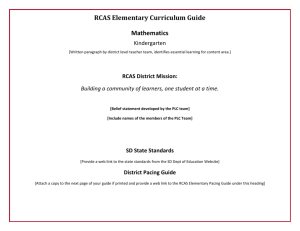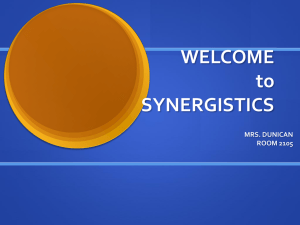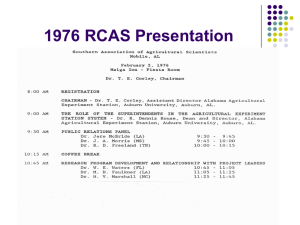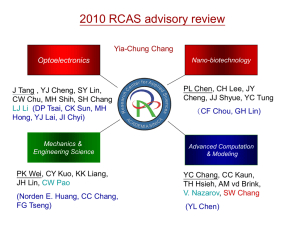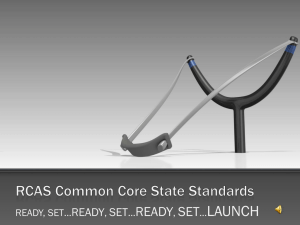T Reserve Component Automation System (RCAS) ARMY PROGRAMS
advertisement

ARMY PROGRAMS Reserve Component Automation System (RCAS) T he Reserve Component Automation System (RCAS) is a scalable, open-systems environment, automated information system that supports commanders with information needed for Reserve Component mobilization and day-to-day administrative operations. It is a sustaining base networked system of workstations, primarily employing commercial off-the-shelf (Microsoft Office® and Windows NT®, etc.) and government off-the-shelf software applications (Unit Level Logistics System, Standard Property Book System-Redesigned, and Standard Installation/ Division Personnel System - ARNG, etc.). RCAS will interface with numerous DoD and Army systems, and certain National Guard and Army Reserve designated standard systems. RCAS will not deploy with mobilized units, but will supply data to support mobilization. RCAS was developed and deployed in eight increments. The RCAS Increment 8 Limit User Test (LUT) tested all the administrative functionality in the RCAS Increment 8 software package. The LUT included regression testing to ensure the new software functionality and operating system upgrades did not negatively affect previous installed functionality at all operational integration sites. The test consisted of mobilization scenarios with focus on specific tasks related to unit mobilization. The test consisted of a planned continuity of operations plan. During the continuity of operations plan, the team observed the unit’s ability to shut down the RCAS server and conduct recovery operations without loss of data. These eight increments of RCAS were found effective and suitable. Increment 8 was fielded in August 2003. TEST & EVALUATION ACTIVITY The Army Test and Evaluation Command executed an operational test for RCAS Increment 8 from February 14 to April 11, 2003. The objective of the test was to determine the effectiveness, suitability, and survivability of RCAS with the addition of Increment 8 software. Primary among the enhancements of Increment 8 software were three new RCAS applications. They are External Interface Error Reporting (EIER), Integrated Data Viewer – Safety and Occupational Health (IDV-SOH), and Permanent Order System (POS). EIER provides the system administrators a consolidated error reporting capability for external interfaces. IDV-SOH provides RCAS regional/state sites the capability to view, but not edit, safety and occupational health data entered regional sites. POS supports the creation, modification, and dissemination of permanent orders for Modified Table of Organization and Equipment and Table of Distribution and Allowances Reserve Component units. Two previously fielded applications were enhanced with additional capabilities in Increment 8. They were the Force Authorization Enhancement III (FA) and the Mobilization Planning Data Viewer – II (MPDV-II). The FA Enhancement III has new search filter elements and ad-hoc reporting. MPDV-II now includes logistics functions and enhanced the form for integration of soldier readiness. The general test concept was to observe users performing typical actions in their normal operational environment, and collect user inputs regarding the new RCAS functionalities using web-based questionnaires and direct user interviews. Additional data was collected by server-installed monitoring software and tester reviews of relevant logs, reports, and other documentation. The data collected was evaluated against 117 published measures of effectiveness and performances. Test units included the National Guard and Army Reserve The Reserve Component Automation System is a scalable, opensystems environment, automated information system that supports commanders with information needed for Reserve Component mobilization and day-to-day administrative operations. 101 ARMY PROGRAMS Headquarters, Delaware Army National Guard, and sites of the 99th Army Reserve Regional Support Command in Pennsylvania and Virginia. Regression testing conducted on all seven previous increments showed that Increment 8 did not adversely effect the system’s operations. Continuity of Operations testing was successfully exercised by the Delaware Army National Guard. TEST & EVALUATION ASSESSMENT The Increment 8 operational test found that, although some features had shortcomings, all five new or enhanced RCAS applications operated in an acceptable fashion. The threshold for successful completion of RCAS developed application transitions is 95 percent. The POS was used extensively with the activities to support Operation Enduring Freedom and Operation Iraqi Freedom. POS, IDV-SOH, and EIER each exceeded the threshold of a 95 percent success rate in attempted transactions. The enhancements made to the previously delivered mobilization application significantly reduced the time to mobilize, once paper mobilization records were converted to electronic documents. A few common data elements in the Unit Personnel System application were not shared in the MPDV-II application and this caused two of seven functionalities to fail to achieve the desired threshold for the Army National Guard. This was corrected in a Maintenance Release 8.1 that was successfully installed and tested in May 2003. The RCAS logistics support, interoperability, and overall security features operated at acceptable levels. Policies and procedures for Continuity of Operations are adequate. Some network and server vulnerabilities were discovered during the vulnerability assessments. These were primarily due to lack of training on installation of security oriented software patches. RCAS provides the user with tools that significantly improve their day-to-day management of soldiers and it ingrate personnel, mobilization, and logistic functions which allows sharing of soldier readiness. DOT&E finds, with the full fielding of Increment 8, RCAS to be operationally effective, suitable, and survivable. This final Increment completes DoD oversight of the development and deployment of RCAS, effective August 2003. 102
